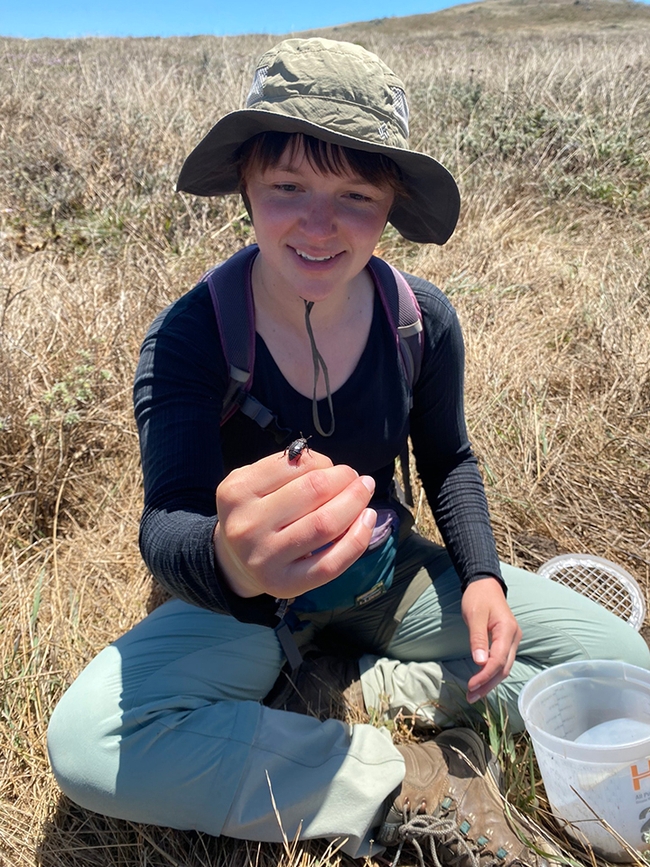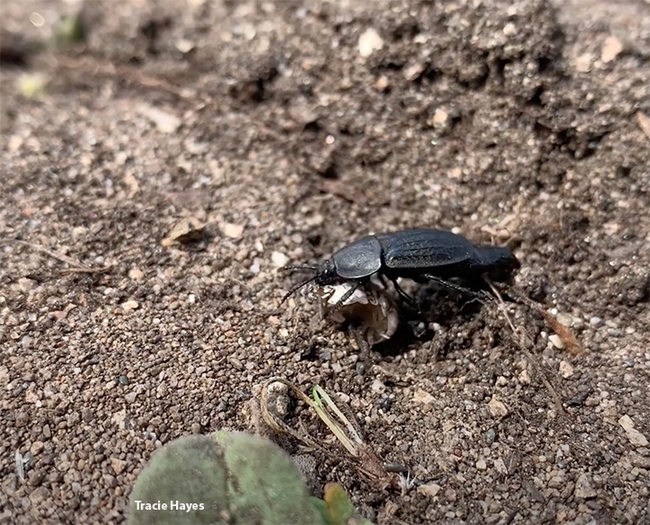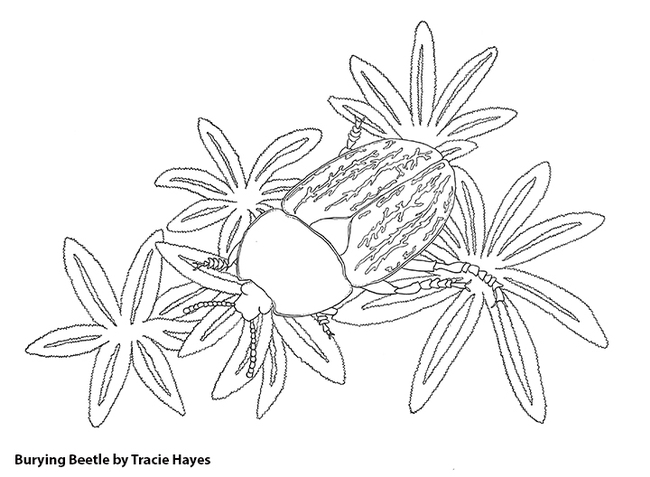
On the more serious side, you'll probably never see the "burying beetle" research that ecologist-artist Tracie Hayes, a doctoral candidate in the laboratory of Professor Louie Yang, UC Davis Department of Entomology and Nematology, does at the restricted-access Bodega Marine Reserve.
But you can if you attend the Bohart Museum of Entomology open house from 1 to 4 p.m., Sunday, Jan. 22 in Room 1124 of the Academic Surge Building, Crocker Lane, UC Davis campus.
The open house will showcase scores of beetle species, and ecologist-artist Hayes will be among the scientists participating.
Hayes researches the yellow-bellied burying beetle, Nicrophorus guttula, at the Bodega Marine Reserve. She's also an accomplished artist and intricately draws the insect and its environment.
Burying beetles, as their name implies, bury small carcasses, like mice, birds and squirrels, and use them to feed their larvae.
"We have about a million beetle specimens in our global collection of eight million insect specimens," said Lynn Kimsey, director of the Bohart Museum and a UC Davis distinguished professor of entomology.
The event, open to the public, is free and family friendly. The arts-and-crafts activity will be to color a drawing of a carrion beetle (genus Heterosilpha), the work of Hayes.
N. guttula, described by Russian entomologist Victor Motschulsky, belongs to the order Coleoptera and the family Silphidae (carrion beetles).
“Burying beetles are really very similar to us,” said Hayes, noting that the male and female meet, pair up, engage in building their home, and help feed the offspring. “They find a good carcass to settle down with; a pair gets to know each other by stridulating back and forth; and then they will prepare their home by burying the carcass and building a nice nursery chamber. After eggs are laid and larvae hatch, both parents will help feed the offspring.”
“I became interested in burying beetles when I was exploring potential field sites during my first year (of graduate school), and came across some carrion beetles, Heterosilpha ramosa, at the Bodega Marine Reserve,” said Hayes, who grew up in Charlotte, N.C., received two degrees from the University of North Carolina at Chapel Hill, and joined the UC Davis population biology graduate program in 2019. “I was captivated by their abundance and movement across the landscape and started reading the literature about carrion beetles generally.”
“I came across a lot of cool experiments with these important scavengers and realized they could be a useful system for asking questions about resource scarcity in space and time,” Hayes related. “Later that summer I set out mice carcasses across the reserve to see if I could find burying beetles (carrion beetles in the genus Nicrophorus), and I was lucky enough to catch multiple Nicrophorus and witness their fascinating behaviors in the field.”
At the open house, Hayes will present a video she created, "A Clearance of Death on Behalf of Life" at https://youtu.be/cGLOE7SrbiU, and field questions about the insect and her research.
Hayes presented a research poster on “Moisture Modulates Ephemeral Resource Patch Quality for Burying Beetle Reproduction” at two 2022 scientific meetings: the Entomological Society of America Joint Annual Meeting, Vancouver, Canada, an also at the 2022 American Society of Naturalists Meeting, Pacific Grove, Calif.
What sparked her interest in entomology? “I like working with insects because they usually come at a scale amenable to ecology experiments, they are super diverse, leading to a diversity of potential questions, and because they are beautiful--especially my charismatic Nicrophorus!” Hayes said.
“Also, burying beetles serve as a model system for studying organisms that specialize on resources that are rare in space and time. These ‘ephemeral resource patches'-- in this case, small carcasses--act as epicenters for interesting ecological interactions.”
A highlight of her research: “Last summer, using experimental chambers in the field, I measured reproductive output across a range of conditions. I found that pairs require a fresh carcass over a dry one in order to reproduce successfully, and competition from the generalist carrion beetle Heterosilpha reduces total offspring count. Both competition and carcass moisture affect the quality of the carcass as perceived by these beetles. Under shifting environmental conditions and species interactions under climate change, burying beetles, as specialists of ephemeral resource patches, may serve as indicators of how organisms will respond to change in general.”
National Science Foundation. Hayes received a $138,000 National Science Foundation Graduate Research Fellowship (GRP) in 2019, and in 2022, was awarded a $25,000 Russell J. and Dorothy S. Bilinski Bodega Marine Laboratory Fellowship.
A 2017 alumna of UNC-Chapel Hill, with the highest distinction, Tracie holds a bachelor of science degree in biology with honors, and a bachelor of arts degree in studio art, with highest honors. Her work experience includes lab manager for the Echinacea Project, Chicago Botanic Garden; research intern for the Dell Ecology Lab, National Great Rivers Research and Education Center, Alton, Ill.; and undergraduate researcher for the Hurlbert Lab, UNC-Chapel Hill.
Engaged in teaching, outreach and science communication at UC Davis, Hayes served recently as a teaching assistant for the course, Entomology 001 “Art, Science and the World of Insects,” and as the communications facilitator, mentor, and workshop leader for the UC Davis Evolution and Ecology Graduate School Preview Program. She created a Bohart Museum of Entomology specimen display drawer, “Here Today, Gone Tomorrow: Insects that Use Ephemeral Resources,” in 2022.
In the art-communications world, Hayes gained experience as the 2013-2016 managing editor, design editor and writer for the Carolina Scientific magazine, UNC's premier undergraduate science journal, and as the 2014 - 2015 artist-in-residence and arts editor, for Event Horizon magazine, a literary and graphic arts periodical at Chapel Hill.
Her career plans? “I hope to keep doing ecology and get a faculty position eventually,” Hayes said. “I would also like to work across disciplines and incorporate art-making into my research and future career as much as possible.”
Beetle Scientists
Folsom Lake College professor Fran Keller, a Bohart Museum scientist and a UC Davis doctoral alumna of entomology, is scheduled to discuss darkling beetles, members of the family Tenebrionidae. Scientists from the California Department of Food and Agriculture also will be a key part of the open house.
The Bohart Museum, dedicated to "understanding, documenting and communicating terrestrial arthropod diversity," was founded in 1946 and named for UC Davis professor and noted entomologist Richard Bohart. In addition to its global collection of eight million insect specimens, it houses a live "petting zoo," featuring Madagascar hissing cockroaches, walking sticks and tarantulas; and a year-around gift shop, stocked with insect-themed books, posters, jewelry, t-shirts, hoodies and more.
The museum is open to the public from 8 a.m. to noon, and 1 to 5 p.m., Mondays through Thursdays.
Attached Images:

A carrion beetle, genus Heterosilpha, from a screen shot of a video by UC Davis doctoral candidate Tracie Hayes, an ecologist and artist.

The Bohart Museum's family arts-and-crafts activity will be to color this drawing of a carrion beetle, genus Heterosilpha, by doctoral candidate Tracie Hayes, an ecologist and artist. (Credit: Tracie Hayes)